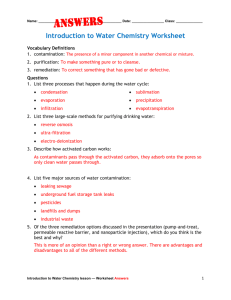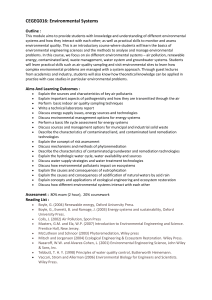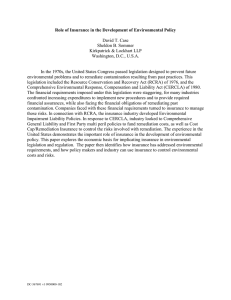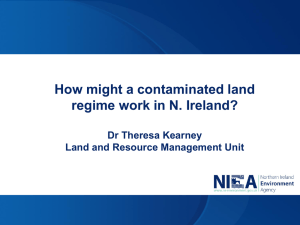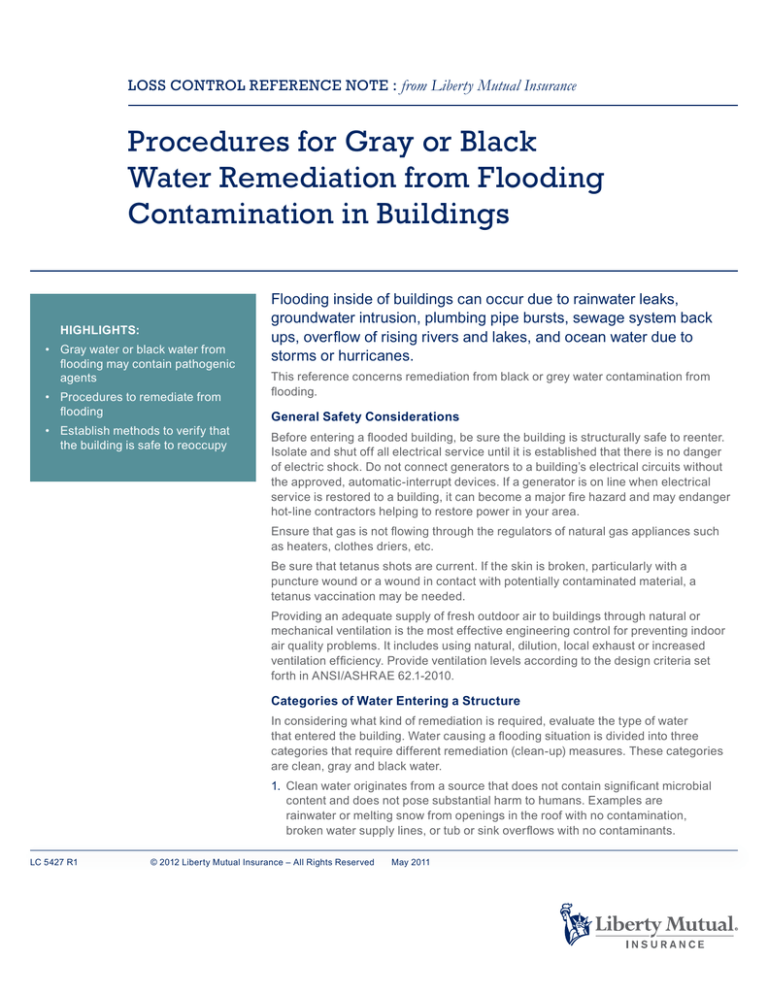
LOSS CONTROL REFERENCE NOTE : from Liberty Mutual Insurance
Procedures for Gray or Black
Water Remediation from Flooding
Contamination in Buildings
HIGHLIGHTS:
• Gray water or black water from
flooding may contain pathogenic
agents
• Procedures to remediate from
flooding
• Establish methods to verify that
the building is safe to reoccupy
Flooding inside of buildings can occur due to rainwater leaks,
groundwater intrusion, plumbing pipe bursts, sewage system back
ups, overflow of rising rivers and lakes, and ocean water due to
storms or hurricanes.
This reference concerns remediation from black or grey water contamination from
flooding.
General Safety Considerations
Before entering a flooded building, be sure the building is structurally safe to reenter.
Isolate and shut off all electrical service until it is established that there is no danger
of electric shock. Do not connect generators to a building’s electrical circuits without
the approved, automatic-interrupt devices. If a generator is on line when electrical
service is restored to a building, it can become a major fire hazard and may endanger
hot-line contractors helping to restore power in your area.
Ensure that gas is not flowing through the regulators of natural gas appliances such
as heaters, clothes driers, etc.
Be sure that tetanus shots are current. If the skin is broken, particularly with a
puncture wound or a wound in contact with potentially contaminated material, a
tetanus vaccination may be needed.
Providing an adequate supply of fresh outdoor air to buildings through natural or
mechanical ventilation is the most effective engineering control for preventing indoor
air quality problems. It includes using natural, dilution, local exhaust or increased
ventilation efficiency. Provide ventilation levels according to the design criteria set
forth in ANSI/ASHRAE 62.1-2010.
Categories of Water Entering a Structure
In considering what kind of remediation is required, evaluate the type of water
that entered the building. Water causing a flooding situation is divided into three
categories that require different remediation (clean-up) measures. These categories
are clean, gray and black water.
1. Clean water originates from a source that does not contain significant microbial
content and does not pose substantial harm to humans. Examples are
rainwater or melting snow from openings in the roof with no contamination,
broken water supply lines, or tub or sink overflows with no contaminants.
LC 5427 R1
© 2012 Liberty Mutual Insurance – All Rights Reserved
May 2011
2. Gray water contains a significant level of contamination and has the potential to cause discomfort or
sickness if consumed by or exposed to humans. Gray water carries microorganisms and nutrients
for microorganisms. Examples may include sump pump failures, seepage due to hydrostatic
pressure or floodwater, broken aquariums, or overflows from washing machines and dishwashers.
3. Black water contains pathogenic agents and is grossly unsanitary. Black water contains sewage
and other contaminated water sources entering or afflicting the indoor environment. Such water
sources carry silt and organic matter into structures and create black water conditions. Toilet
backflows that originate from beyond the toilet trap and contaminated floodwaters are often
considered black water contamination, regardless of the physical content or color of the water.
Procedures for Gray or Black Water Remediation from Flooding
Gray water or black water from flooding may contain pathogenic agents, including human or animal
waste. This water may also be contaminated with chemicals such as pesticides, heavy metals,
gasoline or other petroleum products. Where gray or black water intrusions have occurred in
buildings, additional measures are needed to protect against pathogens.
All floodwater from lakes, rivers or other bodies of water are considered black water, and should be
treated as follows.
Handle Black Water Flooding as though it Contains Infectious Organisms
Those who perform remediation work after floods should wear impermeable, rubber gloves and
a suitable respirator (at least an N-95 disposable dust mask) to avoid breathing spores and other
contaminated particulate, and protective eyewear while handling contaminated material. They should
wash their hands with soap and water after handling contaminated material and before eating,
smoking, drinking or performing other hand to mouth actions.
Make Provisions for Handling Worker Injuries
Most cases of sickness associated with flood conditions are brought about by ingesting contaminated
food or water. Tetanus, however, can be acquired from contaminated soil or water entering broken
areas of the skin, such as cuts, abrasions or puncture wounds. If a cleanup worker experiences any
of the signs or symptoms associated with tetanus, appropriate first-aid treatment and medical advice
should be sought. If the skin is broken, particularly with a puncture wound or a wound in contact with
potentially contaminated material, a tetanus vaccination may be needed if it has been five years or
more since the individual’s last tetanus shot. Since recommendations for immunization may change
depending upon conditions, reference the CDC website prior to assigning workers to these areas.
Remove Standing Water Immediately
Excess water may be mopped or mechanically extracted by a pump or wet vacuum system. Black
water that is extracted from a building should be disposed of in a sanitary sewer system or removed
from the site by a septic waste transporter.
Dry Affected Areas as Soon as Possible
Drying will help stop the spread of mold and bacteria. This may be done before or during remediation.
Note the Four General Principles of Drying Water-Damaged Buildings at the end of this note.
Remove and Clean the Contents of the Building
Prior to beginning any of the remediation work, remove contents (furnishings, draperies, etc.) from the
remediation area. Clean, wrap in plastic, and store the contents that can be salvaged in a humiditycontrolled storage area, less than 60% relative humidity (RH), to prevent mold growth.
If cleaned contents are stored on site, provide a clean enclosure maintained at a slight positive
pressure in relation to the remediation area so that no contamination from other areas of the building
can enter the decontaminated area. Use a separate storage facility if a suitable storage space is not
available on site.
• Files and Papers. Remove and dispose of non-essential wet files and paperwork.
Essential (i.e. legal documents, tax returns, etc.) wet paper from water damage area
should be moved to a location where it can be dried, photocopied and then discarded.
Use Plastic Curtains and Other Appropriate Containment Enclosures to Isolate the Contaminated
Area from the Rest of the Building and Prevent Spreading Contamination
LC 5427 R1
2
Perform cleaning within containment enclosures to prevent mold or bacteria from spreading to
previously cleaned areas.
A vacuum or air mover having HEPA filters should be used to keep containment areas under negative
pressure with respect to the rest of the building or floor. This negative pressure system should run
during the removal of contaminated material and during cleaning and treating of all contaminated
structural and building material components. Exhaust air to the outside of the building.
The following activities should be conducted inside the containment area:
1. Remove all movable objects from the containment area(s).
2. Cover all non-movable objects with polyethylene sheeting.
3. Place ample dehumidification equipment throughout the
containment area to keep the air below 60% RH.
4. Block off and cover all HVAC supply and return vents.
5. Remove all water-damaged and mold-damaged wallboard from the walls and ceiling. Continue
removal for 16 to 24 inches (depending on wall framing spacing) past the perimeter of the damage.
6. Use airless sprayers for dust control and sanitation.
7. Remove water damaged and/or mold contaminated carpet and padding.
Allow only remediation workers inside the containment. Those who remediate in areas flooded with
black water should avoid taking potentially contaminated clothes and shoes into clean, non-effected
areas of a building or structure. Hands should be cleaned thoroughly before entering any clean area.
Clean Moderately Contaminated Structural Material
Assess the potential contamination of the wall studs and floor joists once the drywall and flooring are
removed.
Hard, non-porous surfaces, such as metal wall studs, that are structurally sound should be cleaned
with an EPA approved biocide rated for elimination of both pathogenic and non-pathogenic organisms.
Numerous quaternary ammonium chloride products are rated for black water remediation. Use a
pump sprayer or approved fogger to apply biocides. Be aware that biocides are irritants that can
bother sensitive workers until the biocide dries.
Disinfect mops, brooms and brushes with a quaternary ammonium solution after flushing thoroughly
with water. Contact time should be ten minutes. Flushing with water should be followed with wring out
and a thorough drying outside in the open air.
After work is completed, dry the materials by using air movement (e.g., fans blowing air across the
surface) coupled with dehumidification to keep room air below 60% RH.
Clean Moderately Contaminated Articles
Wipe down all semi-porous (e.g., wood, concrete) and non-porous (e.g., metals, glass, and
hard plastics) articles with EPA-approved biocide solution diluted to the manufacturer’s dilution
specifications. As mentioned above, be aware of the biocide’s irritant affects.
Clean Air Conditioning/Heating Unit and Ductwork
A qualified HVAC contractor should determine if the black water contamination has been introduced
into the HVAC system. If the lined duct has been contaminated with floodwaters, the insulated duct
should be removed and replaced. Shut off and then clean the inside of the air conditioning/heating
unit and ductwork. A variety of biocides are recommended by HVAC manufacturers for use with HVAC
components. Seal adjacent duct openings (supply and return openings) in all affected rooms during
remediation work. Use a licensed HVAC contractor to complete the repairs and to reconstruct the
system.
Remove Water-Damaged Porous Material
Porous material can contain mold and bacteria that can be harmful to health.
• Remove all visible, mold-contaminated porous material, including affected drywall, pressboard,
paneling, insulation, cabinets, carpet, carpet padding, furring strips, etc. Saturated plaster,
gypsum board (dry wall) and insulation should be removed at least 12 to 24 inches from
the line of contamination, then replaced. Double-bag materials and seal for disposal.
LC 5427 R1
3
• Upholstered office partitions, chairs and other large permeable objects that cannot be
thoroughly cleaned and disinfected should be removed and discarded. Remove all porous items
that have been wet for more than 48 hours that cannot be thoroughly cleaned and dried.
• Remove and dispose of all wet ceiling tiles within 24-48 hours of water
damage. Visible mold growth or stains should not be covered with sealants or
coatings, such as Fosters or Kilz ®, but rather should be discarded.
• Carpeting. Remove and discard carpeting and/or padding that has been contaminated
with black water. The concrete floor or sub-floor beneath carpeting or other floor covering
systems should be thoroughly cleaned and dried before the floor covering is replaced.
Launder Moderately-Contaminated Materials
Washable materials can be washed in a commercial washing system. Non-contaminated items should
not be mixed with items contaminated with floodwater or black water.
Post-Remediation Assessment Sampling
After remediation is complete, but prior to reconstruction, conduct verification sampling within the
building to ensure the remediation was successful and no significant residual mold contamination is
present in the structure. An air scrubber (HEPA-filtered) should be operated and exhausted inside
(recirculation mode) the containment area for one to three days after the remediation, and shut off
24-hours prior to the post-remediation test. The containment sheets should not be removed until a
successful post-remediation assessment is achieved.
Establish Methods to Verify that the Building is Safe to Reoccupy
Odors or visible contamination are signs that the building should undergo further remediation before
it is reoccupied. Moisture readings in gypsum board should not exceed 14%. Relative humidity should
not exceed 60% in the interior of the building.
Four General Principles of Drying Water-Damaged Buildings
1. Remove Excess Water: Remove excess water prior to restoration procedures.
Typical equipment used for this are pumps and wet/dry shop vacuums.
2. Evaporation using Moving Air: After removing excess water, the remaining water must be
evaporated using air-moving equipment to move air over all the surfaces that had been wetted.
3. Dehumidify: Use dehumidifiers in addition to fans to avoid secondary condensation.
High capacity dehumidifiers are frequently required. In cold, dry winter
conditions, introducing and heating outside air can be equally effective.
4. Control Temperature: Both evaporation and dehumidification are enhanced by using
building’s Heating Ventilation and Air Conditioning (HVAC) system or auxiliary heaters.
The following precautions must be taken:
• Follow proper safety practices if auxiliary heaters are used, including
those associated with electrical power supplies and venting.
• Do not increase temperatures above 80°F without controlling relative
humidity (RH) below 60%, as this may accelerate mold growth.
LC 5427 R1
4
Additional Resources
Several state and federal agencies may have websites that provide more detailed information on the
potential health hazards of floodwater. Links to websites that provide hurricane clean up and worker
safety information are listed below:
Centers for Disease Control and Prevention, Protect Yourself from Mold:
http://www.bt.cdc.gov/disasters/mold/protect.asp
Environmental Protection Agency, Flood Cleanup: http://www.epa.gov/iaq/pubs/flood.html
Federal Emergency Management Agency, Flood: http://www.fema.gov/hazards/floods/floodf.shtm
National Safety Council, Air Quality Problems Caused by Floods: http://www.nsc.org/news_
resources/Resources/Documents/Air_Quality_Problems_Caused_by_Floods.pdf
OSHA Factsheet, Flood Cleanup: http://www.osha.gov/OshDoc/data_Hurricane_Facts/Bulletin2.pdf
New York City Department of Health and Mental Hygiene, Guidelines on Assessment and Remediation
of Fungi in Indoor Environments: http://www.nyc.gov/html/doh/html/epi/moldrpt1.shtml
The illustrations, instructions and principles contained in the material are general in scope and, to the best of our knowledge, current at the time of publication. No attempt
has been made to interpret any referenced codes, standards or regulations. Please refer to the appropriate code-, standard-, or regulation-making authority for interpretation
or clarification. Provided that you always reproduce our copyright notice and any other notice of rights, disclaimers, and limitations, and provided that no copy in whole or in
part is transferred, sold, lent, or leased to any third party, you may make and distribute copies of this publication for your internal use.
© 2012 Liberty Mutual Insurance. All rights reserved.
LC 5427 R1


